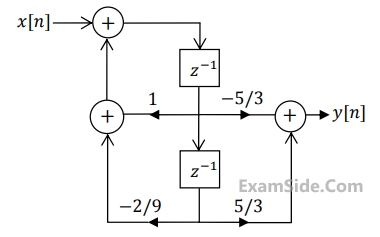Signals and Systems
1
GATE ECE 2015 Set 1
MCQ (Single Correct Answer)
+2
-0.6
The pole-zero diagram of a causal and stable discrete-time system is shown in the figure. The zero at the origin has
multiplicity 4. The impulse response of the system is ℎ[n]. If ℎ[0] =1, we can conclude.


2
GATE ECE 2015 Set 3
MCQ (Single Correct Answer)
+2
-0.6
A realization of a stable discrete time system is shown in the figure. If the system is excited by a
unit step sequence input x[n ] , the response y[ n] is


3
GATE ECE 2015 Set 3
MCQ (Single Correct Answer)
+2
-0.6
Suppose x $$\left[ n \right]$$ is an absolutely summable discrete-time signal. Its z-transform is a rational function
with two poles and two zeroes. The poles are at z = ± 2j. Which one of the following statements is
TRUE for the signal x=$$\left[ n \right]$$ ?
4
GATE ECE 2014 Set 3
Numerical
+2
-0
The z-transform of the sequence x$$\left[ n \right]$$ is given by x(z)= $${1 \over {{{(1 - 2{z^{ - 1}})}^2}}}$$ , with the region of convergence $$\left| z \right| > 2$$. Then, $$x\left[ 2 \right]$$ is ____________________.
Your input ____
GATE ECE Subjects
Signals and Systems
Network Theory
Control Systems
Digital Circuits
General Aptitude
Electronic Devices and VLSI
Analog Circuits
Engineering Mathematics
Microprocessors
Communications
Electromagnetics